

Human Women of Greek Myth. Human Women in Greek MythsThe mortal heroines, victims, and villainesses of Greek myth Which Mythic Queen Are You Quiz Acacallis Acacallis is a kind of boring story - but that's okay, because it isn't really a story about a girl, it's a story about a city.
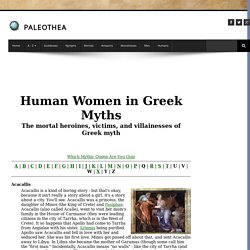
You'll see. Sixwholeseeds: A map of the Underworld of Greek... Matthew Kressel - 36 Days of Judaic Myth: Day 28, The Business of Demons. To celebrate the October 13th release of my forthcoming debut novel, King of Shards, I will be featuring one new blog entry a day about a different Judaic myth for 36 days.

Today’s entry is on The Business of Demons. Day 28: The Business of Demons One of the Se’irim, or hairy demons. Portfolio de : romancephotos - Page 6.
Alphabets. Conjurations - Transcription and translation. Object of Intrigue: The Devil's Bible. The Codex Gigas, captured in a stereoscopic image in 1906.

(Photo: National Library of Sweden) One book at the National Library of Sweden stands out among the rest: the Codex Gigas. Bound in wood, consisting of 620 pages that are each nearly three feet long, and weighing in at 165 pounds, it is quite a hefty tome. Dictionnaire infernal : répertoire universel des êtres, des personnages, des livres... qui tiennent aux esprits, aux demons... (6e éd.) / par J. Collin de Plancy.
Dictionnaire Infernal. The Dictionnaire Infernal (English: Infernal Dictionary) is a book on demonology, describing demons organised in hierarchies.

It was written by Jacques Auguste Simon Collin de Plancy and first published in 1818. There were several editions of the book; perhaps the most famous is the 1863 edition, which included sixty-nine illustrations by Louis Le Breton depicting the appearances of several of the demons. Many but not all of these images were later used in S. L. MacGregor Mathers's edition of The Lesser Key of Solomon.
History[edit] The book was first published in 1818 and then divided into two volumes, with six reprints—and many changes—between 1818 and 1863. A review in 1822 read: Dictionnaire Infernal. Goetia. Aleister Crowley's variant of the Goetic circle and triangle, magic symbols/objects used in the conjuration of the seventy-two spirits of the Ars Goetia Goetia or Goëtia[Notes 1] is a practice that includes the conjuration of demons, specifically the ones summoned by the Biblical figure, King Solomon.
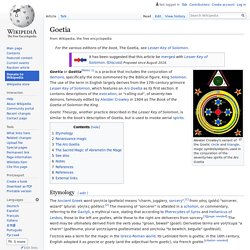
The use of the term in English largely derives from the 17th-century grimoire Lesser Key of Solomon, which features an Ars Goetia as its first section. It contains descriptions of the evocation, or "calling out", of seventy-two demons, famously edited by Aleister Crowley in 1904 as The Book of the Goetia of Solomon the King. Goetic Theurgy, another practice described in the Lesser Key of Solomon, is similar to the book's description of Goetia, but is used to invoke aerial spirits.
Etymology[edit] Γοητεία was a term for the magic in the Greco-Roman world. Renaissance magic[edit] God's angels names,Guide/Guardian Angel name, Find soul mate. A timeline of the Ancient Middle-East. World History Timeline World history timeline map showing the world in 1215. List of demons in the Ars Goetia. Greek and Egyptian Religious Parallels. God's angels names,Guide/Guardian Angel name, Find soul mate.
10 Universal Myths Of The Ancient World. Religion No matter where you’re from, you probably have your fair share of wild myths.
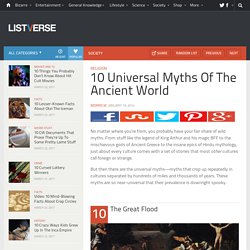
MITHRAS = CHRISTIANITY. This religion, cloaked in mystery and secrecy, has captivated the imaginations of scholars for generations.
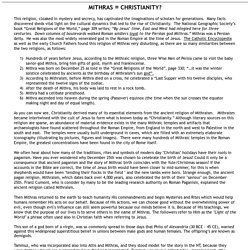
Many facts discovered sheds vital light on the cultural dynamics that led to the rise of Christianity. The National Geographic Society’s book “Great Religions of the World,” page 309 writes; “By Jesus’ time, East and West had mingled here for three centuries. Down columns of boulevards walked Roman soldiers loyal to the Persian god Mithras.” MITHRAS = CHRISTIANITY. What are Angels? An angel?
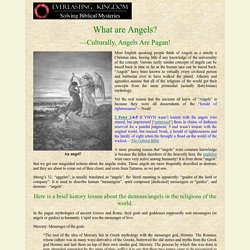
Most English speaking people think of Angels as a strictly a Christian idea, having little if any knowledge of the universality of the concept. Various eerily similar concepts of angels can be traced back in time as far as the human race can be traced back. “Angels” have been known to virtually every civilized person and barbarian ever to have walked the planet. Notes on the Nephilim: The Giants of Old. Notes on the Nephilim: The Giants of Old James Montgomery Boice | Henry Morris | Chuck Missler | Ray C.

Stedman | Arnold G. Fruchtenbaum | Rick Lanser | Bob Deffingbaugh, Th.M. from Genesis, James Montgomery Boice, Baker Books, Copyright 1998. What are Angels? Angels in Greco-Roman Religion and Polytheism. Greek and Roman Gods and Mythology Guide *** Greek and Roman Mythology GuideGreek and Roman Mythology contain stories of the Greek and Roman gods, goddesses, people, places and events that feature in Roman and Greek myths and legends.

Greek and Roman Mythology contain traditional stories that have endured over a long time. The old, famous stories, tales and legends that feature in Greek and Roman Mythology are designed to thrill, terrify, entertain and inspire the listeners. Roman and Greek Gods and Goddesses *** Cambion. In mythology and literature, a cambion /ˈkæmbiən/ is the offspring of an incubus and a human. Creation[edit] A cambion is most often depicted as the offspring of an incubus and a human woman. Etymology[edit] Angel. Supernatural being in various religions and mythologies The Harmony between Religion and Science, a ceiling fresco of the Marble Hall at Seitenstetten Abbey (Lower Austria) by Paul Troger, 1735 Etymology[edit] The word angel arrives in modern English from Old English engel (with a hard g) and the Old French angele.[7] Both of these derive from Late Latin angelus (literally "messenger"), which in turn was borrowed from Late Greek ἄγγελος angelos,[8].
Additionally, per Dutch linguist R. S. Classification of demons. There have been various demonologies (classifications of demons) in Christian demonology and classical occultism and Renaissance magic. Classification systems are based on the nature of the demon, the sin with which they tempt people, the month in which their power was strongest, the saints that were their adversaries, or other characteristics. Classification by domain[edit] It can be noted that according to each author listed below, the domain of each demon is very different (with the exception of Francesco Maria Guazzo, who seem to have copied Michael Psellus with little difference).
Hierarchy of angels. Orthodox icon of nine orders of angels. A hierarchy of angels is a belief or tradition found in the angelology of different religions, which holds that there are different levels or ranks of angels. Higher ranks may be asserted to have greater power or authority over lower ranks, and with different ranks having differences in appearance, such as varying numbers of wings or faces. Abrahamic faiths[edit] The Jewish angelic hierarchy is established in the Hebrew Bible, Talmud, Rabbinic literature, and traditional Jewish liturgy. They are categorized in different hierarchies proposed by various theologians. Family tree of the Greek gods. Key: The essential Olympians' names are given in bold font. Difference Between Ancient Roman & Egyptian Religions. Greek and Egyptian Religious Parallels. Interpretatio graeca. Methodology for cultural comparison Interpretatio graeca (Latin, "Greek translation") or "interpretation by means of Greek [models]" is a discourse[1] used to interpret or attempt to understand the mythology and religion of other cultures; a comparative methodology using ancient Greek religious concepts and practices, deities, and myths, equivalencies, and shared characteristics.
God Talk: And Other Incoherent Religious Delusions - James Copenhaver, L. Rodney Sheffer. Arthur Rosenfeld. Hawaiians refer to it as mana, the Greeks called it pneuma, the Japanese call it ki, yogis know it as prana, devout Christians might think of it as the Holy Ghost, martial artists know it is energy, and my 10-year-old son insists it the ineffable force that lends atoms awareness of themselves.
Spelled qi (pronounced 'chee') in pinyin Chinese (otherwise ch'i), it is the root currency of Traditional Chinese Medicine, that energy that TCM practitioners manipulate to fight disease and assure health. Who would win in a fight—the Vatican Swiss Guards or the US Secret Service? - Quora. Military in Vatican City. The State of Vatican City is an enclave country which lies entirely within Rome, the capital of Italy. The responsibility for defending the state from an aggressor lies primarily with Italy's armed forces.
Vatican City has within its territory the Pontifical Swiss Guard or Swiss Guard. Military technology: Laser weapons get real. Eve and the Identity of Women: 7. Eve & Lilith. In an effort to explain inconsistencies in the Old Testament, there developed in Jewish literature a complex interpretive system called the midrash which attempts to reconcile biblical contradictions and bring new meaning to the scriptural text. Listverse. Mysteries. Tuscan demon-busters told to go by the book after a rise in irregular exorcisms - Europe - World - The Independent. The situation is so serious that the city’s Archbishop, Cardinal Giuseppe Betori, has written to remind clergy that exorcisms must be undertaken only in certain situations and with permission.
Around 15 official exorcisms have been conducted in Tuscany in recent years, according to the local press. Exorcists warn Vatican over 'beautiful young vampires' and satanic yoga - Europe - World - The Independent. Why Are So Many People Snobby About Fantasy Fiction? Many Interacting Worlds theory: Scientists propose existence and interaction of parallel worlds. Book of the Dead. Book of Gates. Hell. Scientists at Large Hadron Collider hope to make contact with PARALLEL UNIVERSE in days. Excalibur. St. Peter's Basilica - Vatican City. The World's Best Photos of confessio. The Confessio Sancti Petri. Ancient Saint Peter's. Vatican's Sistine Chapel: Fascinating Facts/Background. Nercopolis. Tomb Of St. Peter In Rome - The Vatican Necropolis. Mudslides protected ancient Vatican necropolis from ravages of time - TheCatholicSpirit.com : TheCatholicSpirit.com. Vatican Necropolis. Pope Francis makes emotional pilgrimage to the Vatican's city of the dead to visit St Peter's tomb.
The bones of St. Peter.